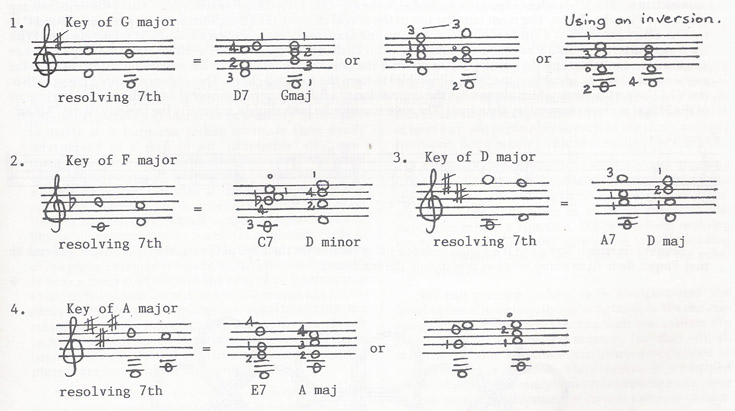
Fretboard Harmony 4
By
Student Exercise: To review the categories of fusion and tension as introduced in the last F.B.H. column, name fully the following intervals, and then describe each one as being either constant, neutral, or mildly / strongly dissonant.
Share this:
[feather_share]
To recap, the basic chords of a key consist of consonant (and neutral) intervals. When major or minor 7th, 9ths, and later diminished or augmented notes appear in these triads, dissonance or instability is created which must then be resolved. At the beginner/intermediate stage of music study, this mostly concerns the dominant 7th chord and its interaction with other chords of the key.
The answers to last issue’s exercise on resolving chords around given intervals are:
From these examples some simple rules should be noted:
- The dissonance of the 7th in the dominant chord resolves by falling a step of a semitone to the 3rd of chord I (the chord of the keyname).
- If the 3rd of the dominant chord is the upper most voice (the soprano), this will rise to the tonic or root note of Chord I. (see 2nd solution of answer No 1 above)
- If the 3rd of the dominant chord is an inner voice, it may rise to the tonic or fall to the 5th, of chord I. (see 1st solution of answer No 1 above)
- When writing in 4 voices as the above chord has been done, it will require the doubling of a note to expand the basic triad from 3 to 4 notes. For this, double the root note. The dominant 7th chord can have just its 4 constituent notes (2nd solution, answer No 1) or it can have the 5th omitted with the root note doubled to take its place.
(1st solution, answer No 4 above). These considerations about the horizontal movement of voices from one chord to another, form the subject known as VOICE LEADING. The music of Sor and Barrios comes to mind as splendid examples of this craft upon the instrument – Sor for his classicism and Barrios for his innovation on the guitar. As some students would be aware, the movement of the dominant 7th chord to other chords of the key, forms CADENCES.
CADENCE – “harmony that has the effect of punctuating a melody in the way full stops or commas punctuate written sentences” – N. Long; “a formula that occurs at the end of a composition, a section, or a phrase, conveying the impression of a momentary or permanent conclusion.” – Harvard Dictionary of Music.
The dominant 7th can be involved in any of the following harmonic movements, and its dissonance always has to be resolved. (all examples given in the key of C major) V7 -ii (i.e. chord 5 to chord 2, or G7 to D minor) V7 -iii (G7 to E minor) V7- IV (G7 to F major) V-VI (G to A minor) V7 -I (G7 to C major, the Perfect Cadence) IV- I (F major to C major) forms the Plagal Cadence, but as both these chords are consonant there is no dissonance of the 7th interval to resolve. Its voice leading is set out below.
Each of these chord progressions has a different musical impact and directs the harmonic flow of tension and fusion in its own particular way. Up to about 4th grade standard, V7-I, IV-I and V7-VI will be the most commonly seen cadences. The V7 -I cadence has been looked at in the answers to last issue’s exercises, so has the voice leading of the IV-I Plagal Cadence. The most familiar use of the Plagal Cadence is as the chordal accompaniment “Amen” to hymns. Since chord IV is a consonant chord with no specific dissonances, its voice leading is relatively free. With the inner parts, try to take a line of least resistance, that is, do not leap up or down with a voice if a step (a tone or semitone) is available, and do not step up or down if the note can be retained in the oncoming chord. Double the root note of chord IV (doubling the 5th is allowable) to form the 4 voiced chord. This cadence is more passible than the V7-I Perfect Cadence which always has the impression of a full stop or permanent close to the music -the impact of the Plagal is more momentary than final. The note common to both chords, is usually the melody of the “Amen.”
Student Exercise: Write out the Plagal cadence progressions for the keys of G maj D maj, A maj, F maj and Bb maj. Finger them in as many ways as possible on the fretboard.




